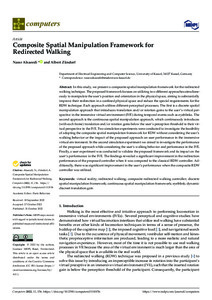| dc.date.accessioned | 2022-11-16T13:54:21Z | |
| dc.date.available | 2022-11-16T13:54:21Z | |
| dc.date.issued | 2022-10-31 | |
| dc.identifier | doi:10.17170/kobra-202211167129 | |
| dc.identifier.uri | http://hdl.handle.net/123456789/14251 | |
| dc.description.sponsorship | Gefördert durch den Publikationsfonds der Universität Kassel | |
| dc.language.iso | eng | |
| dc.rights | Namensnennung 4.0 International | * |
| dc.rights.uri | http://creativecommons.org/licenses/by/4.0/ | * |
| dc.subject | virtual reality | eng |
| dc.subject | redirected walking | eng |
| dc.subject | composite redirected walking controller | eng |
| dc.subject | discrete spatial manipulation framework | eng |
| dc.subject | continuous spatial manipulation framework | eng |
| dc.subject | eyeblink | eng |
| dc.subject | dynamic discreet translation gain | eng |
| dc.subject.ddc | 004 | |
| dc.title | Composite spatial manipulation framework for redirected walking | eng |
| dc.type | Aufsatz | |
| dcterms.abstract | In this study, we present a composite spatial manipulation framework for the redirected walking technique. The proposed framework focuses on utilizing two different approaches simultaneously to manipulate the user’s position and orientation in the physical space, aiming to substantially improve their redirection in a confined physical space and reduce the special requirements for the RDW technique. Each approach utilizes different perceptual processes. The first is a discrete spatial manipulation approach that introduces translation and/or rotation gains to the user’s virtual perspective in the immersive virtual environment (IVE) during temporal events such as eyeblinks. The second approach is the continuous spatial manipulation approach, which continuously introduces (with each frame) translation and/or rotation gains below the user’s perception threshold to their virtual perspective in the IVE. Two simulation experiments were conducted to investigate the feasibility of adopting the composite spatial manipulation framework for RDW without considering the user’s walking behavior or the impact of the proposed approach on user performance in the immersive virtual environment. In the second simulation experiment we aimed to investigate the performance of the proposed approach while considering the user’s walking behavior and performance in the IVE. Finally, a user experiment was conducted to validate the proposed framework and its impact on the user’s performance in the IVE. The findings revealed a significant improvement in the redirection performance of the proposed controller when it was compared to the classical RDW controller. Additionally, there was significant improvement in the user’s performance when the composite RDW controller was utilized. | eng |
| dcterms.accessRights | open access | |
| dcterms.creator | Alsaeedi, Nassr | |
| dcterms.creator | Zündorf, Albert | |
| dc.relation.doi | doi:10.3390/computers11110156 | |
| dc.subject.swd | Virtuelle Realität | ger |
| dc.subject.swd | Simulation | ger |
| dc.subject.swd | Immersion <Virtuelle Realität> | ger |
| dc.subject.swd | Fortbewegung | ger |
| dc.subject.swd | Manipulation | ger |
| dc.subject.swd | Kognition | ger |
| dc.type.version | publishedVersion | |
| dcterms.source.identifier | eissn:2073-431X | |
| dcterms.source.issue | Issue 11 | |
| dcterms.source.journal | Computers | eng |
| dcterms.source.volume | Volume 11 | |
| kup.iskup | false | |
| dcterms.source.articlenumber | 156 | |


